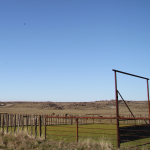
Photo by Jim Gain
In a case of “déjà vu all over again,” the Stanislaus Audubon Society has filed a Writ of Mandate challenging Stanislaus County Supervisors’ approval of the Willms Ranch parcel split on January 29. In 1995, after a long round of litigation, a superior court reversed Stanislaus County’s approval of a proposed golf course on the Willms Ranch after Stanislaus Audubon fought the decision.
Though different in substance, this case has striking similarities. The crux of the issue is the County’s “Mitigated Negative Declaration.” In essence, the County has said there are no possible negative effects from the parcel split.
While Stanislaus Audubon Society objects on a number of grounds, one of the chief issues is the abundance of bird life on the County’s east side. Nature lovers find it easy to see Bald Eagles soaring above Willms Road in late fall, winter, and early spring. Those who know their birds also see Golden Eagles, Prairie Falcons, Burrowing Owls, and a host of other raptors. According to the California Environmental Quality Act (CEQA), such species as the Bald Eagle should at the very least be mentioned in virtually any land use review, but there was no mention of Bald Eagles in the Willms approval.
The California Environmental Quality Act also forbids “piecemeal” approval of projects with potentially harmful long-term effects. Willms’ attorneys have argued that the parcel split in itself doesn’t necessarily mean ranchettes and hobby farms will follow, and if they do, an Environmental Impact Review (EIR) can be done in that event. The Audubon Society’s position is that the parcel split itself is growth-inducing and must therefore trigger an EIR.
The California Farm Bureau has taken a clear position against ranchettes and hobby farms because they interfere with true farm production. It’s hard to imagine a reason other than ranchettes for the parcel split. Even if there were another reason, the split will surely increase the likelihood of ranchettes, and ranchettes are certain to have impacts on wildlife, land values, social services, and other environmental factors.
Those who criticize CEQA claim it’s too easily abused to forestall beneficial projects. But in a state so clearly damaged by ill-advised growth, it’s foolish to say we’d be better off with less oversight.
In a recent editorial, the Modesto Bee recommended County Supervisors approve the Willms Ranch parcel split. Longtime Bee readers will realize that this is the newspaper that favored construction of a city the size of San Francisco on the floodplain habitat of an endangered species (UC Mapes). It touted Diablo Grande as the “economic engine” that would energize our local economy. It played soft music while Gerry Kamilos engaged the region in one of the longest and most futile slow dances anyone can remember (West Park).
The Bee has always considered CEQA an arcane and byzantine obstacle to progress. But over the years, the Bee has helped lead our region into the bottom tier of “worst” rankings for cities. Maybe it’s time for Bee management to take a closer look at the consequences of ill-advised land use.

hey, we have lots of great birds in Salida , please come help defend us from the developers